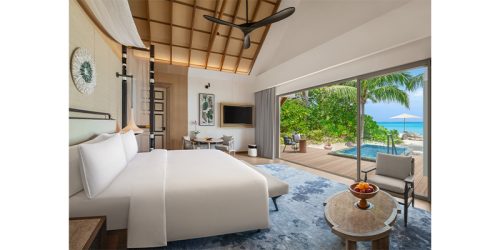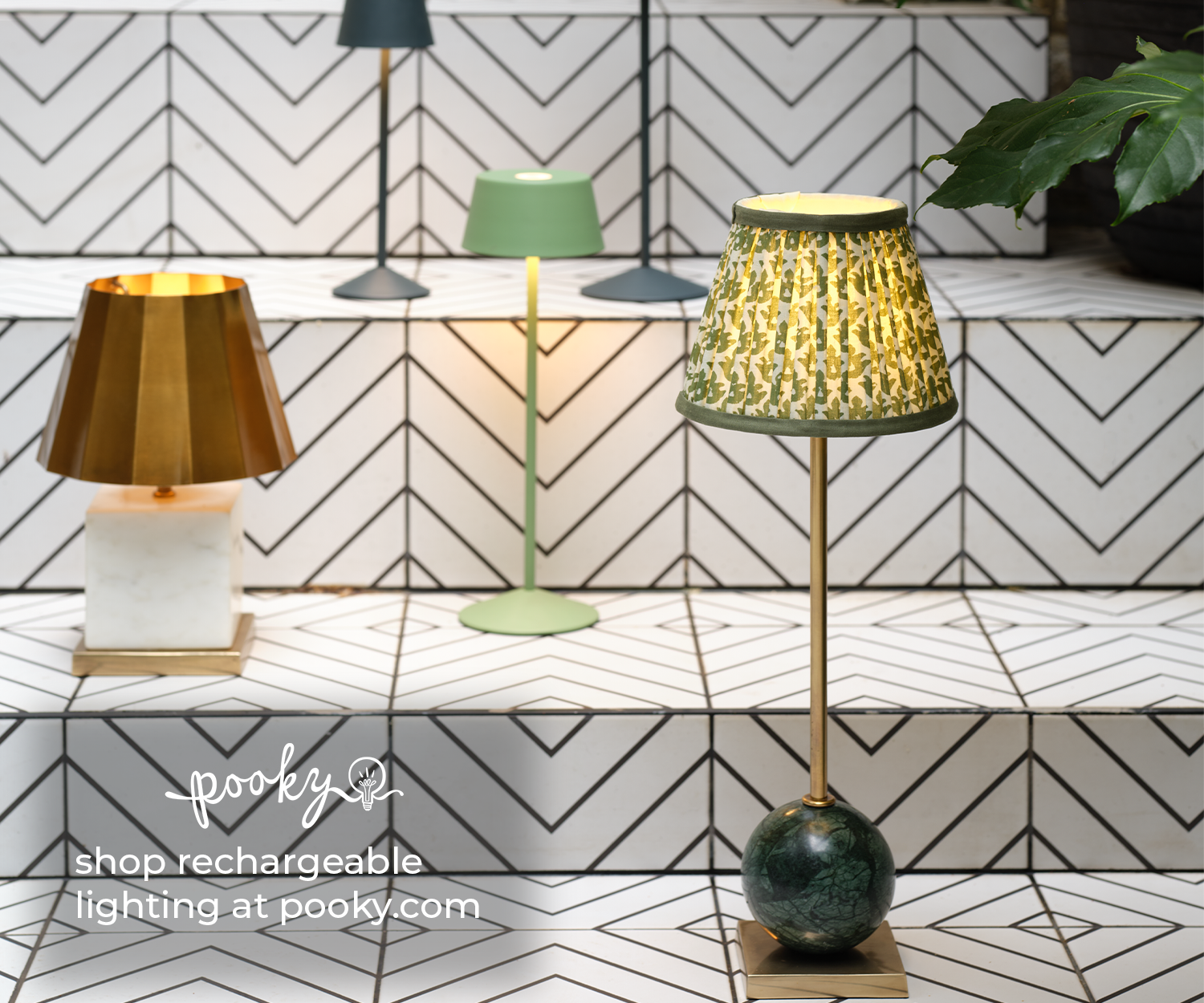Four Seasons Osaka, Japan
The fourth iteration of the brand in Japan, Four Seasons Osaka takes hospitality to new heights with a skyscraper property that houses a Japanese ‘ryokan in the sky’.
A glossy black vase the size of a small boulder hangs on invisible strings in the entrance of Four Seasons Osaka, apparently defying gravity. Crafted in impossibly smooth, highly polished sumi lacquer, and decorated with kokedama moss arrangements and foliage, the artwork – entitled ‘Stone’s Dream’ – is juxtaposed with the hewn, white-stone panels that adorn nearby pillars. The dramatic stonework is a reference to the slabs used to build the foundations of nearby Osaka Castle, whose distinctive white keep is visible from the upper floors of this new hotel in the One Dojima tower.
Opened in August 2024, the 175-room hotel is Four Seasons’ fourth property in Japan, alongside Four Seasons Hotel Tokyo at Marunouchi – with its three-Michelin-star restaurant Sézanne; the sky-scraping Four Seasons Hotel Tokyo at Otemachi, which opened in 2020; and its first property, Four Seasons Kyoto, which opened in 2016 and set the standard for resort hotels in the ancient capital.
Located on the site of the 17th-century Dojima Rice Exchange – the world’s first commodity futures exchange – Four Seasons Hotel Osaka is located over 10 floors of the 195-metre building and promises the same, lauded service of its brand siblings combined with its own spirit and sense of place in Japan’s vibrant third city. This year (2025), Osaka takes centre stage as host of Expo 2025 Osaka, the World Expo taking place over six months from April.
Four Seasons Osaka has firmly set out to reflect Osaka’s welcoming approach with its open and inviting lobby, which has comfortable social seating, a bakery-café, and an all-day dining restaurant. Designed by Gwenael Nicolas’ Tokyo design studio, Curiosity, (Nicolas is also the artist behind ‘Stone’s Dream’) the calm, double-height space features textured stone alongside an abundance of polished granite, light louver screens and pools inside and out – a nod to Osaka Castle’s magnificent inner and outer moats. Flowing easily through the space, guests turn right for the front desk, beside which is another of Nicolas’s works – ‘Thousand Mirrors’ – sculpted in polished stainless-steel panels, that casts impressions of the lobby like ripples on a pond.
To the left, the current runs towards the social and dining areas, past the pocket Cha Lounge (serving hand-picked teas), and a grand staircase to the second floor ballroom. Here, tactile wallcoverings have been created by renowned textile artist Reiko Sudo, while at the base is an amorphous sculpture in urushi lacquerware by Kyoto artist Genta Ishizuka. Named ‘Inner Cycle’, it is mesmerising in its high-gloss, natural gradation from amber to deep brown. Beyond, is Farine artisan bakery (for all manner of delectable brioches) and Jardin restaurant, where the international, semi-buffet breakfast (try the Yaki Onigiri take on eggs Benedict) and afternoon tea are served.
Jardin benefits from ample natural light and the thoughtful planting – of maples, cherries, rhododendrons and camellias – that screen guests from the road and adjacent blocks. Outside, the garden has soft lounge seating and high tables with stools, interspersed among small pools and shrubs. A sculpture in looping knots of stainless steel, entitled ‘Le Noeud de Babel’, by Jean-Michel Othoniel sits atop a mirror reflecting the Dojima One Dojima tower. On the south-east corner is the five-metre tall, striding, polished-aluminium sculpture, ’Trans-Mio’, by Osaka artist Kohei Nawa.
A glowing amber lift lobby, with the polish of a lacquer box, breaks the lobby’s muted spell, whisking guests skywards to where Curiosity has created the first 154 rooms over seven floors (the 29th to 35th). Stepping out onto the accommodation floors, guests are greeted with ink works by Tokyo-born calligraphy artist, Ayoko Someya, who has taken inspiration from the history and seasons along the Dojima River. Her works are among the 300 pieces selected by Fumio Nanjo, curator and historian, former director of the Mori Art Museum in Tokyo.
In natural tones, wood and stone, the guest bedrooms (from 43sqm) are awash with light and expansive views. Each has king or twin double beds, down pillows and duvets and subtle lighting. Covetable bedside lamps feature lantern shades made by Kyoto Nishijin-silk expert Hosoo. When switched on, the intricate and highly technical silk weaving of the white ‘Clouds’ fabric gently diffuses light. Marble bathrooms are replete with large Japanese soaking tubs and Natura Bissé amenities.
Tucked away on the 28th floor is the jewel in the crown: a first-of-its-kind, contemporary ryokan (Japanese inn) called Gensui. This ‘hotel within a hotel’ takes its name from the Japanese characters gen, for deep black, and sui for water, and is a discreet sanctuary comprising 15 rooms and three suites. Designed by Tokyo-based studio Simplicity, as a ‘modern expression of Japanese customs and design principles’, the Gensui floor has a completely different feel to the rest of the hotel. Different spaces emphasise light and shadow, even darkness, while elsewhere, rooms are bathed in light from huge picture windows.
Low lighting, grey tiles and monochrome artworks greet guests as they step out of the lift to be greeted by uniformed staff wielding cups of green tea. They are whisked down hushed, dark-wood corridors with soft edges to their rooms, where guardian ‘Butler’ statues, crafted in driftwood by Tokyo artist Yuji Sampei, mark each entrance. Inside, contrastingly bright guest rooms feature large futon beds on raised wood platforms, sliding doors, washi-paper headboards, deep black-marble soaking tubs and the lingering scent of freshly laid tatami. Low-slung, circular chairs, custom-designed by Simplicity, enable guests to sit closer to ground level – even cross-legged.
Gensui guests have exclusive access to the SABO lounge, a tranquil space with monochrome furnishings, art-deco style globe lamps and leather banquettes. Light-filled by day, when darkness falls, it offers sparkling views across the city.
This serenity permeates up to the 36th floor, where Simplicity has also created The Spa at Four Seasons – a lofty, 650sqm temple to wellbeing that embraces natural materials including stone, timber and clay plaster. Curvilinear walls create a space that flows from a tree-like terrazzo column by Ayako Ueda to five treatment rooms, including one couple’s room with a private bath. In a homage to Osaka’s vibrant bathing culture, male and female areas both feature large ofuro bath tubs, with showers, amenities and wooden oke buckets, as well as a dry sauna. Two private ofuro are available for families and couples or those in search of solo relaxation. Sky-top views are embraced in the 24-hour fitness centre and the 16-metre, stone-clad infinity pool which looks out onto the ‘City of Water’ below. Beside the pool, a large sculpture in Gohare limestone, by Ayako Ueda, encapsulates the soft flow of time and the waterways that flow into Osaka Bay.
The vibe changes dramatically as you step out on the 37th floor, where Tokyo-based Design Studio Spin has created a Cantonese restaurant and bar with confidence and pizzazz, utilising the cityscape as a backdrop, much as it did, 39 floors up, at Four Seasons Hotel Tokyo at Otemachi.
The 37th-floor lobby features a large a water feature in the shape of a lotus flower, with dramatic lighting and a clipped bonsai at its centre. Behind the fountain, a shimmering curtain of glass crystals appears to cascade down the glass walls of the hotel’s glamorous night spot, Bar Bota. Adjacent is Sushi L’Abysse Osaka by three-Michelin -star chef Yannick Alléno and master sushi chef Itaru Yasuda, which opened in October with 18 counter seats and a private dining for up to six guests.
A theatrical, arched corridor leads to the signature Cantonese restaurant, Jiang Nan Chun, with its olive and grey dining room and Osaka views. Double-height windows, effective panelling and vertical chandeliers, give the 88-seat restaurant a generous sense of space. Lounge sofas and armchairs set around circular tables are well appointed and accented with cushions and bolsters in Hosoo’s ‘Blink’ and ‘Herringbone’ silks in black, white and grey tones. Elsewhere, textured black ‘Grape’ and red ‘New York’ fabrics add pops of colour and texture.
Alcoves are filled with ceramic vases and there are freestanding louvered and lattice cabinets of glassware. Behind a dramatic, six-metre-high folding screen, upholstered in a bespoke Nishijin silk by Hosoo, is one of two 10-seat semi-private dining rooms, with an eye-catching vertical chandelier of glass lanterns that sparkle above the rotating-server tables.
Head across the hallway for a night cap beside the ceiling-to-floor picture windows of Bar Bota. A beautiful oval centrepiece – decorated with hexagonal tiles and illuminated with scores of globe pendants – dominates the space, its shelves loaded with Japanese gins, whiskies, spirits utilised in its ‘Heritage Sips’ menu of classic cocktails reimagined with Japanese ingredients. Under foot, matt and gloss tiles in wide stripes and tessellated hexagons and trapezoids encircle the bar, with patterns reflected in geometric cushion fabrics and occasional tabletops. Silk-upholstered glass and wood cabinets are filled with design tomes and quirky objets.
The overall effect is one of elegance and poise but also fun – something travellers a sure to find in abundance in Osaka.
















